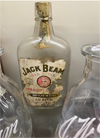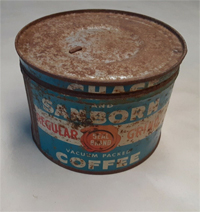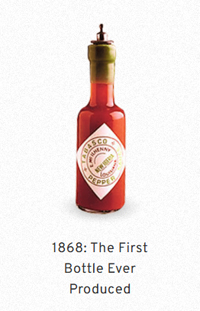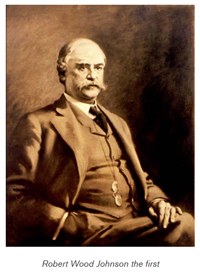
The President’s Message:
Our May speaker will be Ken Corhan.
His program will be about General Henry Wager Halleck who was
described as a man completely lacking in physical attractiveness or
charm-pop-eyed, flabby, surly, and crafty.
He also had the reputation for being the most unpopular man in
Washington, D.C. during the Civil War.
It will be an interesting evening as we learn more about the
General.
Dues are due. Envelopes for mailing your dues will be available at the
May meeting.
Gerridine LaRovere
May 8, 2024
Program:
Civil War Businesses Still in Operation Today by Adam Katz
Adam gave this very well-prepared lecture which was recorded on a
digital audio recorder and transcribed by the Notta software.
Because the talk had many short video clips, this review is
missing some of the most impactful elements of his presentation.
We're going to be talking about businesses that started before the war
that are still in existence today.
In addition, he explained that some of these firms were started
during the War and also businesses that started soon after by Civil War
veterans. All these
businesses still exist today; however, some were bought out by larger
companies like Nabisco.
These larger conglomerates you know have products are still made and
still under the same name that they were 160 years ago.
The brands were just owned by other organizations back in the 19th
century.
 A
common theme Adam kept returning to was drunkenness.
Drunkenness was a problem throughout the war.
We've all heard that, but what exactly did they drink?
Whiskey was a very popular drink for Civil War soldiers.
One of the main companies filling this need was Jim Beam.
But how readily available was actually whiskey?
Well, we're gonna find now that in Kentucky alone there were over
2,000 whiskey distilleries not to mention all of the other states.
Jim Bean actually started in 1795; it started way before the
Civil War, 65 years before! A
common theme Adam kept returning to was drunkenness.
Drunkenness was a problem throughout the war.
We've all heard that, but what exactly did they drink?
Whiskey was a very popular drink for Civil War soldiers.
One of the main companies filling this need was Jim Beam.
But how readily available was actually whiskey?
Well, we're gonna find now that in Kentucky alone there were over
2,000 whiskey distilleries not to mention all of the other states.
Jim Bean actually started in 1795; it started way before the
Civil War, 65 years before!
Alcohol whiskey was readily available and of course with all this
whiskey available the iron clad law of economics was in play.
Supply was sky-high, and cost was very low and therefore very
affordable to soldiers, so the whiskey flowed.
That's one of the alcohols that they would drink, whiskey.
And this is not to mention all their own individual concoctions
of whiskey that they would make.
So let us put a thumbtack on booze and talk about clothing.
Rest assured; we will return to strong drink.
Some items the soldiers would not have to buy.
Uniforms were government issue.
In order to have an army you've got to clothe an army.
One of the only major clothing manufacturers that can produce
clothes on a mass market is one we know very well.
At this point Adam played a modern commercial for Brooks
Brothers. The video
explained that years ago, there were many clothing factories.
There had to be an excess of 250 to 300 manufacturers in this
country. Today, we are one
of the only ones standing.
It's just something about being American.
It is who we are. I
think that the reason why people gravitate to Brooks Brothers is because
they can trust in the quality, such that Brooks Brothers makes high
tailored, high-quality products.
So, Abraham Lincoln said - all right in Brooks Brothers we have the
best-looking uniforms that this world has ever seen.
And we've got the highest quality cloth so the Union will have
the best uniforms in the war.
He spent tons of money buying uniforms from Brooks Brothers.
The firm had a different idea in mind.
Brooks Brothers knew they were essentially running a monopoly
because there was no other clothing manufacturer could mass produce
these clothes. Instead of
giving them the highest quality of clothing they ended up with garments
made of scraps of cloth.
The company would even glue the clothing together after a few feeble
stiches and deliver the product with no pockets.
When it would rain or get wet, the glue would come apart.
Grant, who was from the west, would say that the New York - based
company Brooks Brothers produced pocketless, bottomless, and overall
inferior quality pants that continue to receive government contracts to
make uniforms. Throughout
the war, Ulysses S. Grant complained about how awful the uniforms were
and Lincoln would say that's the only place that can make them.
I mean you want mass-produce uniforms, that's only a place.
So, what about this 1853 clothing company that we would all know about a
little bit later? So yeah,
what about Levi Strauss and denim?
Well, the company was around and Levi would actually donate a lot
of money to Lincoln’s campaign in 1864.
Levi Strauss only sold dry goods at this point.
They didn't start selling the blue jeans until 1873.
Besides, the uniforms on both sides were made of wool.
But the soldiers had other sources.
A lot of times the soldier would be forced to buy shirts and
clothes from the sutlers, which the sutler would charge a lot of money.
Next Adam turned to food.
You always heard about the troops who ate salt pork and hard tack.
I've heard it was always, at reenactments, in classes, and in
museums it was always about hard tech and salt pork.
So, I was amazed to find out that there was a ton of other food
that was at the disposal of the Civil War soldiers.
It wasn't quite as bland as what it was made out to be.
And I'm surprised that a lot of this information just isn't
passed down as common knowledge at all those reenactments and
encampments. When they were
marching, they were given 16 ounces of hard tack, which is two to three
crackers about three inches square.
However, when they were in camp, they had a different meal.
In camp they would have camp rations which could substitute soft
bread flour and corn meal.
Because they didn't have to worry about the soft bread spoiling.
For meat they would cook it right away and eat it right away.
Additionally, they had sugar, coffee, and salt.
And this is all by the government issue.
Furthermore, they would have the extra luxuries which could be
dried beans, peas, rice, vinegar, and molasses for flavor.
They were also given soap and candles by the government.
That's as bare bones as what the U.S. Government issued.
But there's actually a ton more food available through sutlers
and all these other companies that probably the sutlers bought products
from that the soldiers could buy.
They set up booths and sold it like peddlers.
If you're a sock sutlers, you can sell socks.
It's basically a store on a wagon.
It is a tad different.
They had to have an official license to sell products.
The Government charged a lot of money to these sutlers.
And the Government would have officials to go to all of these
sutlers and say, “Let me see your permit.”
As promised earlier, we are about to continue the tale of strong drink.
Count Agoston Haraszthy, founded Buena Vista Winery in 1857.
Adam played a video which praised the Buena Vista Sonoma County
Pinot Noir. It claimed that
the wine possesses soft and supple tannins and flavors of cola, Santa
Rosa Plum, and freshly picked cherries.
The label is the original label dated from 1863.
Buena Vista wine was one of the wines that the soldiers had
available. Now, within two
years, before the Civil War, they were selling two million gallons of
wine.
This drink was widespread throughout the entire country.
Even though it was made in California, and they didn't have the
Transcontinental Railroad yet, based on the amount of wine they would
have produced, it would be safe to assume that it made its way through
to the East Coast. It would
have gone by ship around South America.
That's how it gets to the east coast.
But yeah, two million gallons of wine a year.
So again, this is very available, high supply, and you'd have to
know that there are tons of sellers that would sell whiskey or this
wine. With all of this
trade, California was unlikely to side with the South.
Further, perhaps, Lincoln didn't want to lose Kentucky, not
because it was a border state, but because he would lose all his
alcohol.
 If
we can depart from alcoholic beverages for a bit we come to that justly
famous drink, coffee. But
what coffee, Adam asked, did they drink?
Are these companies still around today?
Another video clip explained that ninety-five years before my son
Jimmy was born, Jason Sanborn was roasting coffee, slowly and carefully.
Only the choice beans for the most perfect blend.
The tag line was “What Mr. Chase didn't know about coffee, Mr.
Sanborne did.” Chase &
Sanborn Coffee had a competitor, another California based firm.
The company was called, the Pioneer Steam Coffee Company.
It was originally based out of San Francisco near the Sierra
Nevada Mountains. One of
the investors, a Mr. James Folgers, became a full partner in the firm in
1859. With that he bought
out the rest of his investors and just named the company after himself,
Folgers. To keep the coffee
fresh both coffee companies used tin cans. If
we can depart from alcoholic beverages for a bit we come to that justly
famous drink, coffee. But
what coffee, Adam asked, did they drink?
Are these companies still around today?
Another video clip explained that ninety-five years before my son
Jimmy was born, Jason Sanborn was roasting coffee, slowly and carefully.
Only the choice beans for the most perfect blend.
The tag line was “What Mr. Chase didn't know about coffee, Mr.
Sanborne did.” Chase &
Sanborn Coffee had a competitor, another California based firm.
The company was called, the Pioneer Steam Coffee Company.
It was originally based out of San Francisco near the Sierra
Nevada Mountains. One of
the investors, a Mr. James Folgers, became a full partner in the firm in
1859. With that he bought
out the rest of his investors and just named the company after himself,
Folgers. To keep the coffee
fresh both coffee companies used tin cans.
It was not all food staples, the troops needed snack-food.
After showing a humorous video Adam introduced us to Julius
Sturgis Pretzel Bakery based out of Lititz, Pennsylvania.
They would make pretzels and they would sell them directly to the
soldiers in addition to the
sutlers. Most of the
soldiers from the Union came from Pennsylvania and New York.
Many were from German families so the pretzel was a natural fit.
We have discussed whisky and coffee, but there was another beverage in
the soldier’s mess. What
cool, creamy, refreshing drink did the government contract and provide
to soldiers? That would be
milk, canned milk, that could be stored in warehouses for a long time.
The company is the Borden Company established in 1857 by Gail
Borden. Adam showed a video
featuring Elmer the bull and Elsie the cow.
The government bought thousands of cans for the war and stored it in
warehouses. After the war
there were still thousands of canes that didn't get distributed.
They didn't get distribute at all, Gerridine reminded us, because
the milk was in little cans the soldiers would use these cans for their
coffee. Gail Borden made
money, but due to the logistics of transportation much of it never made
it to the encampments.
Along with the milk, chocolate, Ghirardelli chocolate, also sat, unused,
in Union warehouses. In
another video we learned that Ghirardelli comes from San Fransico.
It probably made the long shipboard voyage that the other west
coast products took. But
the east coast had chocolate too.
In 1764, John Hannon and the American physician Dr. James Baker
started importing beans and producing chocolate in the Lower Mills
section of Dorchester, MA.
Hannon wanted to leave his wife so he packed off to the Bahamas.
When he did not return, Baker assumed total ownership, by paying
Hannon’s wife for Hannon’s share, and changed the name of the firm to
the Baker Chocolate Company.
Whitman's candy also played a role since 1842 out of
Philadelphia, PA.
And we have two other candy companies to discuss.
Gerridine introduced us to Necco, an abbreviation for the New
England Confectionery Company.
While the name Necco had to wait until 1900, the famous Necco
wafers came out of a machine, invented in 1847.
There were a number of flavors around for the Civil War including
mint, chocolate, and clove.
The second organization mad jelly beans.
The earliest known appearance of a jelly bean is a 1861
advertisement for William Schrafft of Boston that promoted the sending
of jelly beans to soldiers in the Union Army during the Civil War.
That ad urged people to send his jelly beans to the soldiers in
the war.
So again, the standard ration that the government issued was basically
salt pork and hardtack, but the soldiers had so much more available to
them, as you can see. The
basic unit for mealtime was the company of 100 men at full strength.
Every company had a well-paid cook.
While the privates made $13.00 per month the cooks were paid
$50.00. Adam thought, as
Napoleon said, that an army marches on its stomach.
I guess the importance of having a well-paid cook was to avoid
under-cooked meat which could, and did, lead to disease.
If they would eat that raw meat, they'd get sick.
So, that's the value of the cook to make sure that the soldiers
are healthy in camp and on the battlefield.
Perhaps you didn't like the salty taste of meat.
There were ways of hiding that taste.
At this point Adam showed a commercial for Gulden's Brown Mustard.
Charles Gulden was born in 1843 and at 17 he worked for his uncle
at the Union Mustard Mills.
He opened his company in 1862, Gulden 's Mustard in New York City.
It was readily available to the soldiers soon.
Many of the soldiers of New York and their families knew about
it, and they probably sent that down to their troops by mail packages.
The
sutlers based out of New York knew about it too.
Charles Gulden did serve in the army and was in a reserve unit at
Gettysburg.
 Adam
did not have much on southern supply, but he did have one product
Tabasco. He ran a
commercial for the sauce.
Tabasco was started by a soldier in Louisiana and he got the recipe from
another family. It was a
family recipe, and he was probably fooling around with this sauce to
cover up the taste of the meat and his other comrades probably said,
“hey, this is pretty good, maybe after the war you could sell it.”
That soldier was Edmund McIlhenny.
It turned out to be a multi-million-dollar product 160 years
later. Adam said he was not
gonna dispute from where the family recipe came.
McIlhenny had the rights to it but he penned it after the war and
he would go on to sell it.
To this day you see his name right on the top of each bottle of Tabasco
sauce. Adam
did not have much on southern supply, but he did have one product
Tabasco. He ran a
commercial for the sauce.
Tabasco was started by a soldier in Louisiana and he got the recipe from
another family. It was a
family recipe, and he was probably fooling around with this sauce to
cover up the taste of the meat and his other comrades probably said,
“hey, this is pretty good, maybe after the war you could sell it.”
That soldier was Edmund McIlhenny.
It turned out to be a multi-million-dollar product 160 years
later. Adam said he was not
gonna dispute from where the family recipe came.
McIlhenny had the rights to it but he penned it after the war and
he would go on to sell it.
To this day you see his name right on the top of each bottle of Tabasco
sauce.
And speaking of bottles, it is time to return to the saga of bottle
contents. In this case, the
contents is beer. Budweiser
was around as well as some other beers.
The major companies brewed beer and not to mention beer that
soldiers brewed themselves.
That was unofficial because they weren't allowed to brew beer in camp.
Adolphus Busch would marry the daughter of Eberhard Anheuser so
the brewery became the Anheuser-Busch beer company.
During the Civil War Busch served as a corporal in the Union Army
from May to August, 1861, enlisting in the 3rd Missouri US Reserve Corps
Infantry Regiment, and fighting in Missouri.
And here you have the lovely couple, Adolphus Busch and his
lovely wife Lilly. This is
a little bit after the war so here's how they would advertise it.
It was a spruce beer, a piney beer, and it was the only thing
standing between the army and slow painful death by scurvy.
They put a lot of, or at least they claimed they did, they put,
lot a of pine fruit in there.
And so that way the soldiers could drink it and it would prevent
them from getting scurry.
If they didn't have fruit or vegetables available, you could drink
Budweiser beer and you'd be okay because the fruit gave you the vitamin
C that you would need to keep away from scurvy.
Spruce beer went all the way back to the Revolutionary times.
Now, the German soldiers, would brew their own beer, and they were
excellent at brewing beer.
And it would cause problems in the Union camps.
Spruce beer was unpopular.
The soldiers didn't really like the taste of spruce beer – it was
kind of fruity, they didn't really like it.
But the Germans brought all their brewing equipment to the camps,
and then they'd brew their own beers.
This created a lot of jealousy and anger among non-German Union
soldiers against the German Union soldiers.
They would ask, “can we have some of your beer?
We'll trade you this product, we'll trade you that product.”
Eventually, it wouldn't become quite as peaceful.
Behavior problems occurred between the American troops and German
units.
The Army attempted to enforce more stringent restrictions on beer for
German units to decrease rowdiness.
The Germans were producing so much beer that the army tried to
make rules against the Germans.
They said you can only make so much beer and you can’t make
anymore because all the other soldiers will get angry when the Germans
wouldn't share their beer.
It didn't quite work out well.
The US Army put pressure on
sutlers to stop selling beer.
The German regiments also began guarding their supply more
closely so they would actually have armed guards around their beer
supply so that at night people wouldn't go in and steal their beer.
Beer created more animosity between German and American soldiers.
 Now
Adam showed a video of very young kids eating birthday cake.
He asked the question: “How do you clean the kids up?”
This led to the story of Robert Wood Johnson.
He was 16 when the war began, and he wanted to go out to fight,
but his mom wouldn't let him.
His two older brothers fought.
Since Robert Wood Johnson couldn't fight the war, he would end up
working an apothecary, or a general store.
And that's where he learned about medicines.
After the War, he would create bandages that were self
-medicated, and that is how we came to the medicated bandage, which
after a few years would take off.
Many of the Civil War veterans would have those meditated
bandaged so that's how Johnson & Johnson got started, Robert Wood
Johnson and his two younger brothers. Now
Adam showed a video of very young kids eating birthday cake.
He asked the question: “How do you clean the kids up?”
This led to the story of Robert Wood Johnson.
He was 16 when the war began, and he wanted to go out to fight,
but his mom wouldn't let him.
His two older brothers fought.
Since Robert Wood Johnson couldn't fight the war, he would end up
working an apothecary, or a general store.
And that's where he learned about medicines.
After the War, he would create bandages that were self
-medicated, and that is how we came to the medicated bandage, which
after a few years would take off.
Many of the Civil War veterans would have those meditated
bandaged so that's how Johnson & Johnson got started, Robert Wood
Johnson and his two younger brothers.
The product was called the Medicated Plaster Adhesive, which was the
medicated Band-Aid. For the
antiseptic, they worked with another doctor, who was a well-known doctor
at that time named Joseph P. Lister.
Known for antiseptics, especially with oral antiseptics, and late
in the war, and after the war, there would be a mouthwash named after
him, Listerine, after Joseph P. Lister in honor of his work.
There were other products named, but in order to keep this newsletter
from overrunning the paper I will only list them:
Kirks’ Soap, James S. Kirk & Co., Milton Bradley board games,
Milton Bradley Company, Sherwin Williams paint, Sherwin Williams
Company, James Spratt dog food, Nabisco, Grape Juice, Welch's Grape
Juice Company, banking Henry Wells and William G. Fargo, American
Express, Wells Fargo, brewers – Blatz, Schlitz, Phillips, Best Brewing,
Miller Brewing Company, and then Obermann Brewing Company.
Last changed: 01/29/24 |

